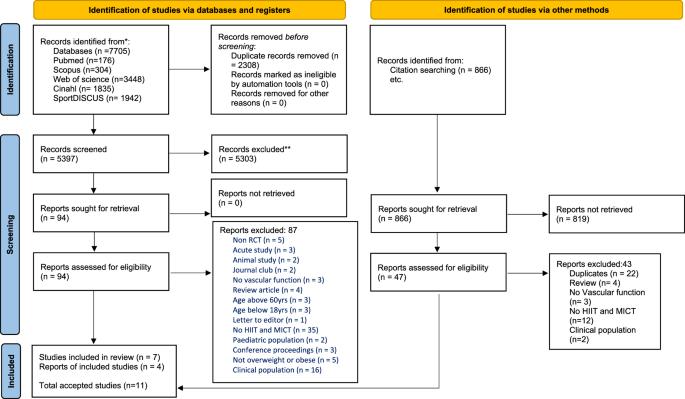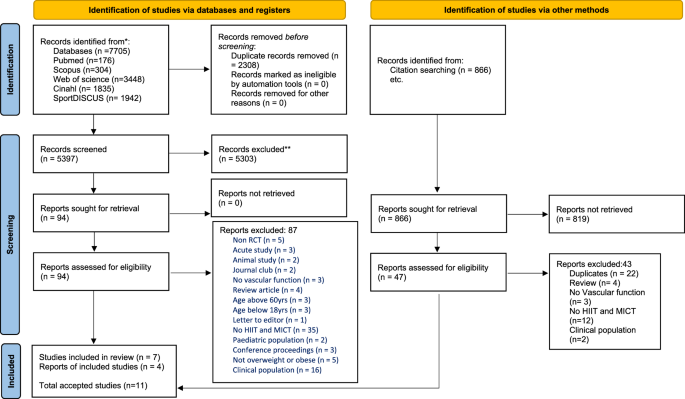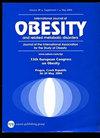Effects of high-intensity interval training versus moderate-intensity continuous training on vascular function among individuals with overweight and obesity—a systematic review
IF 4.2
2区 医学
Q1 ENDOCRINOLOGY & METABOLISM
引用次数: 0
Abstract
The study aimed to investigate and systematically review the evidence relating to the effects of high-intensity interval training (HIIT) versus moderate-intensity continuous training (MICT) on vascular function such as arterial diameter, arterial stiffness, pulse wave velocity, blood flow, etc. in individuals with overweight and obesity. The entire content of PubMed (MEDLINE), Scopus, SPORT Discus® (via EBSCO host), CINAHL, and Web of Science were searched. Only experimental research studies conducted in adult participants aged ≥18 years, published in English before January 2023 were included. A total of 5397 studies were reviewed for the title and abstract with 11 studies being included for data extraction. The review resulted in a total of 346 individuals with overweight and obesity with body mass index (BMI) ranging between 25–36 kg/m2. HIIT and MICT intensities resulted in 85%–95% and 60%–70% maximal heart rate (MHR) respectively. Seven out of 11 studies showed some concerns about the overall risk of bias. Six of 11 studies reported improving vascular function following HIIT than MICT. HIIT is a more effective and time-efficient exercise for enhancing vascular functions in individuals with overweight and obesity, leading to improvements in flow-mediated dilation by 3.9% and arterial diameter by 4.8%, compared to MICT.


高强度间歇训练与中等强度持续训练对超重和肥胖者血管功能的影响--系统综述。
研究背景本研究旨在调查并系统回顾高强度间歇训练(HIIT)与中等强度持续训练(MICT)对超重和肥胖者的血管功能(如动脉直径、动脉僵硬度、脉搏波速度、血流量等)影响的相关证据:方法:检索了 PubMed (MEDLINE)、Scopus、SPORT Discus®(通过 EBSCO 主机)、CINAHL 和 Web of Science 的全部内容。仅纳入了 2023 年 1 月之前发表的、以年龄≥18 岁的成年参与者为对象的英文实验研究:共审查了 5397 项研究的标题和摘要,其中 11 项研究被纳入数据提取范围。审查结果显示,共有 346 人患有超重和肥胖症,体重指数(BMI)介于 25-36 kg/m2 之间。HIIT 和 MICT 运动强度分别为最大心率(MHR)的 85%-95% 和 60%-70%。在 11 项研究中,有 7 项研究的总体偏倚风险令人担忧。11项研究中有6项报告称,HIIT比MICT能改善血管功能:结论:与 MICT 相比,HIIT 是增强超重和肥胖症患者血管功能的更有效、更省时的运动,可使血流介导的扩张率提高 3.9%,动脉直径提高 4.8%。
本文章由计算机程序翻译,如有差异,请以英文原文为准。
求助全文
约1分钟内获得全文
求助全文
来源期刊

International Journal of Obesity
医学-内分泌学与代谢
CiteScore
10.00
自引率
2.00%
发文量
221
审稿时长
3 months
期刊介绍:
The International Journal of Obesity is a multi-disciplinary forum for research describing basic, clinical and applied studies in biochemistry, physiology, genetics and nutrition, molecular, metabolic, psychological and epidemiological aspects of obesity and related disorders.
We publish a range of content types including original research articles, technical reports, reviews, correspondence and brief communications that elaborate on significant advances in the field and cover topical issues.
 求助内容:
求助内容: 应助结果提醒方式:
应助结果提醒方式:


